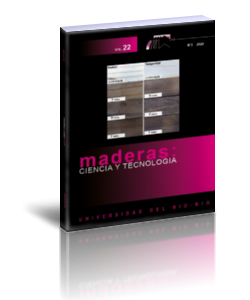Evaluation of the calorific values of wastes from some tropical wood species
Keywords:
Ash content, calorific value, calorific density, energy release, tropical specie, wood biomassAbstract
The paper aims to analyze and classified some exotic wood species from tropical Africa, on regard to calorific features, in order to view the ability of their biomass to be a solid, natural and renewable fuel. The calorific values of wood wastes of eight tropical species were determined using an oxygen bomb calorimeter. The tested specimens were conditioned at a moisture content of 10%, 20%, and 50%. The influence of moisture content on calorific value and density, heat release rate and calorific efficiency were also analyzed. The biggest high calorific value and low calorific value were obtained by Guaiac and Rose species (21200-20700 kJ/kg). Acajou had the lowest values of high calorific value and low calorific value (18929 and 18456 kJ/kg, respectively). For higher wood density (Guaiac) the higher calorific density was obtained. The moisture content of specimens had negatively influenced the calorific efficiency and rate of energy release. The ash content was below 4% with highest values for Guaiac (3.6%) and the lowest for Acajou (0.5%). The results showed that the analyzed tropical wood species had a forest calorific capacity with 23-47% higher than of European beech, thus can be considered a good potential as renewable energy resources.
Downloads
References
Adam, A.-B.; H. Basta, A.; El-Saied, H. 2018. Evaluation of palm fiber components an alternative biomass wastes for medium density fiberboard manufacturing. Maderas-Cienc Tecnol 20(4): 579-594. http://revistas.ubiobio.cl/index.php/MCT/article/view/3220.
AEBIOM. 2019. Statistical Report 2019. European Energy Outlook, European Biomass Association. https://bioenergyeurope.org/statistical-report.html
Asibor, J.; Akhator, E.; Obanor, A. 2019. Energy Potential Study of Some Tropical Wood Species from Nigeria. Current Journal of Applied Science and Technology 37(4): 1-10. https://doi.org/10.9734/cjast/2019/v37i430295
ASTM D3865-12. 2000. Standard Test Method for Gross Calorific Value of Coal and Coke. American Society for Testing and Materials. Philadelphia, Pennsylvania.
ASTM E1755-01. 2003. Standard Method for the Determination of Ash in Biomass, Philadelphia, PA: American Society for Testing and Materials. Pennsylvania.
ASTM D2866–11. 2011. Standard Test Method for Total Ash Content of Activated Carbon, ASTM International. Philadelphia, Pennsylvania.
ASTM D-1102. 1984. Standard test method for ash in wood. American Society for Testing and Materials. Philadelphia, Pennsylvania.
Barros, V.; Melo, A.; Santos, M.; Nogueira, L.; Santos, M.G. 2020. Different resource-use strategies of invasive and native woody species from a seasonally dry tropical forest under drought stress and recovery. Plant Physiology and Biochemistry 147: 181-190. https://doi.org/10.1016/j.plaphy.2019.12.018.
DIN 51900-1 (2000). Determining the gross calorific value of solid and liquid fuels using the bomb calorimeter, and calculation of net calorific value – Part 1. General information. German Institute for Standardization.
EN 14774-1 (2009). Solid biofuels - Determination of moisture content - Oven dry method - Part 1: Total moisture, European Committee for Standardization, Brussels.
Fialho, Lucas de Freitas; Carneiro, Angélica de Cássia Oliveira; Carvalho, Ana Marcia Macedo Ladeira; Figueiró, Clarissa Gusmão; Silva, Carlos Miguel Simões da; Magalhães, Mateus Alves; Peres, Letícia Costa. 2019. Bio-Coal Production With Agroforestry Biomass In Brazil. Maderas-Cienc Tecnol 21(3): 357-366. http://revistas.ubiobio.cl/index.php/MCT/article/view/3535
Gao, K.; Zhang, Z.; Zhu, T.; Tian, X.; Li, T. 2019. The influence of leaf removal on tuber yeld and fuel characteristics of Helianthus tuberous L. in a semi-arid area. Industrial Crops and Products 131: 8-13. https://doi.org/10.1016/j.indcrop.2019.01.024.
ISO 1928 (2009). Solid Mineral Fuels. Determining the Gross Calorific Power by Calorimeter Bomb and Calculus of Net Calorific Power. International Standardisation Institute, New York.
Jasinskas, A.; Streikus, D.; Vanzodas, T. 2020. Fibrous hemp (Felina 32, USO 31, Finola) and fibrous nettle processing and usage of pressed biofuel for energy purposes. Renewable Energy 149:11-21. https://doi.org/10.1016/j.renene.2019.12.007.
Loureiro, B. A.; Sacramento-Vieira, T.; Junqueira-Costa, L.; Barishinikov-Silva, A.; Reis de Assis, M.; Trugilho, F. P. 2019. Selection of superior clones of Corymbia hybrids based on wood and charcoal properties. Maderas-Cienc Tecnol 21(4): 619-630. http://revistas.ubiobio.cl/index.php/MCT/article/view/3766.
Marafon, A C.; Amaral, A. F. C.; de Lemos, E. E. P. 2019. Characterization of bamboo species and other biomasses with potential for thermal energy generation. Pesquisa Agropecuária Tropical 49: e55282. https://doi.org/10.1590/1983-40632019v4955282
Numes, V.; Silva, R.; Romeiro, G.; Azevedo, D. 2020. The speciation of the organic compounds of slow pyrolysis bio-oils Brasilian tropical seed cake fruits using high-resolution techniques: GCxGC-TOFMS and ESI (±)- Orbitrap HRMS. Microchemical Journal 135: Article 104514. DOI: 10.1016/j.microc.2019.104514
Ozyuguran, A.; Akturk, A.; Yaman, S. 2018. Optimal use of condensed parameters of ultimate analysis to predict the calorific value of biomass. Fuel 214:640-646. https://doi.org/10.1016/j.fuel.2017.10.082.
Park, S.; Kim, S.J.; Oh, K.C.; Cho, L.; Kim, D.H. 2020. Investigation of agro-by product pellet properties and improvement in pellet quality through mixing. Energy 190: Article 116380. https://doi.org/10.1016/j.energy.2019.116380.
Perez-Arevalo, J.J.; Velaszquez-Marti, B. 2018. Evaluation of pruning residue of Ficus benjamiana as a primary biofuel material. Biomass and Bioenergy 108:217-223. https://doi.org/10.1016/j.biombioe.2017.11.017.
Ruiz-Aquino, F R.; Ruiz-Angel, S. R.; Feria-Reyes, R. F.; Santiago-Garcia, W. S.; Suares-Mota, M.; Rutiaga-Quinones, J. 2019. Wood chemical Composition of Five Tree Species from Oaxaca, Mexico. BioResources 14(4): 9826-9839. https://ojs.cnr.ncsu.edu/index.php/BioRes/article/view/BioRes_14_4_9826_Ruiz_Aquino_Wood_Chemical_Composition_Tree/7254.
Tsai, W-T.; Lin, Y-Q.; Tsai, C-H.; Chung, M-H.; Yeh, S-I. 2020. Conversion of water caltrop husk into torrefied biomass by torrefaction. Energy 195: Article 116967. https://doi.org/10.1016/j.energy.2020.116967.
Yan, P.; Xu, L.; He, N. 2018. Variation in the calorific value of different plants organs in China. PloS One 13(6) e0199762, https://journals.plos.org/plosone/article ?id=10.1371/ journal.pone.0199762.

































